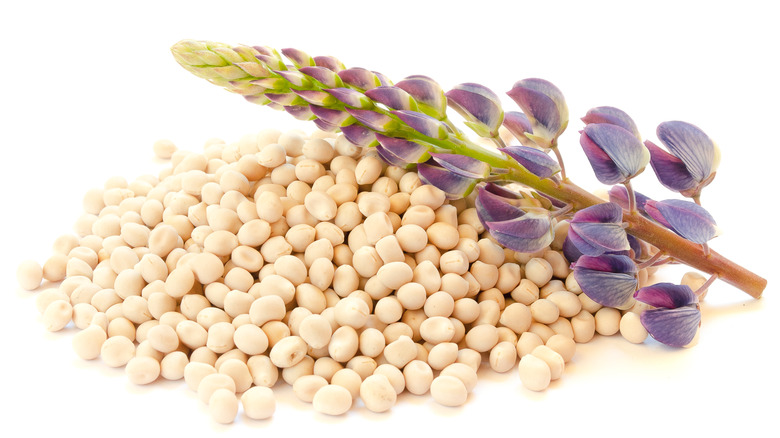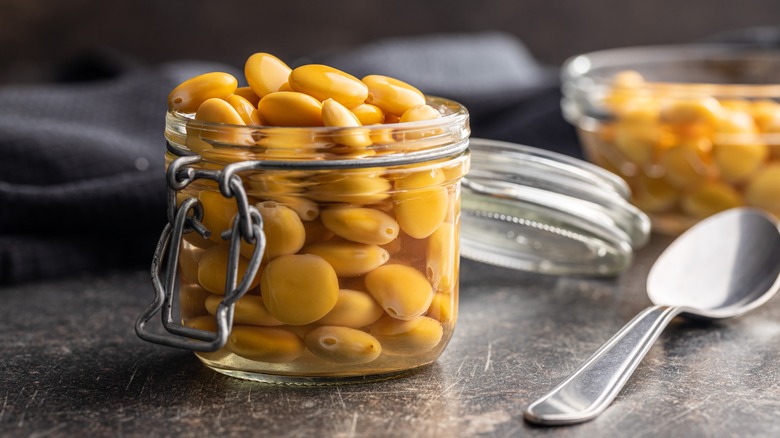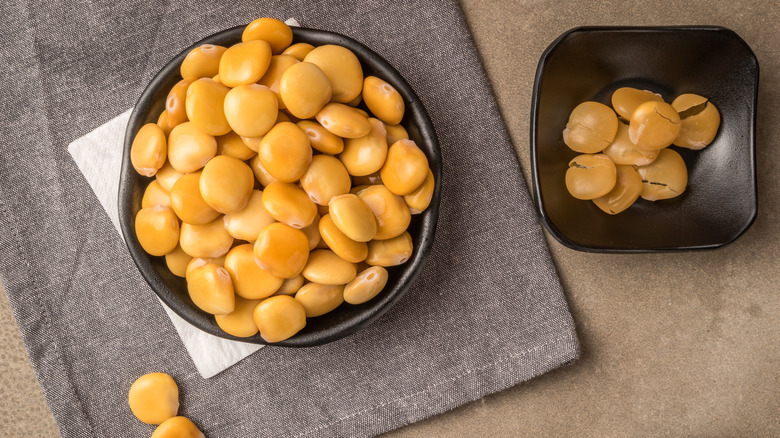Lupini: The Italian Beans That Pack A Protein Punch
Consumers today are becoming increasingly interested in swapping out the meat in their diets for plant-based alternatives. According to The Manual, switching to plant-based meat alternatives can reduce cancer risks and cardiovascular disease, as well as help control blood sugar and reduce inflammation in the body. Bloomberg Intelligence projects the plant-based meat market will be valued at $162 billion by 2030.
A new superfood, which is actually incredibly old, that might help drive this market is the lupini bean (Scientific name: Lupinus Albus, per Health Benefits Times). According to Green Queen, the health food industry is poised to turn lupini beans into the hot new base for meat alternative products. Move over soy, because lupini are ready to take center stage in the plant-based revolution. Lupini are known to have similar amounts of protein to that of soy beans (via Versus) and can be ground into a versatile powder, as noted by Health Benefits Times.
Lupini are also a great snack, topping, or ingredient to be used in a variety of dishes, and are definitely a legume you'll want to know better.
What are lupini Beans
Lupini beans are a flat, light yellow, oval shaped legume with a thick transparent skin on the outside that can be easily removed (via Food and Nutrition). Delighted Cooking says that the plants that grow these beans are often cultivated for decorative reasons. The plants will sprout appealing flowers that turn into seed pods which can be dried and stored to eat later.
According to Nonna Box, lupini beans likely originated in the Middle East and have been cultivated all throughout regions of the Mediterranean. Different styles of lupini can be found as street foods or bar snacks in Italy, Spain, Portugal, Jordan, and Egypt (via Food and Nutrition). Well + Good points out that lupini are also a popular rotation crop for farmers to restore nutrition to their soil.
Luckily, there are plenty of prepared lupini available — and more unique forms of this nutritious powerhouse are coming out every day. The Deluxe Food Lovers Companion says that new, sweeter varieties that don't require such an intense brining period were developed in the 1920s.
Nutritional Benefits of lupini beans
One of the main reasons lupini beans have been elevated from European street food to celebrity status is their nutritional benefits. According to Green Queen, several health food brands have turned to lupini beans for keto-friendly, high protein meat alternatives and snacks. Swedish brand Lupinita has already started marketing their unique product Lupinfilé, which is a soy-free form of tempeh made with lupini.
Precision Nutrition notes that 1 cup of cooked lupini beans contains 26 grams of protein with only 198 calories and 16 grams of carbohydrates. It also has 5 grams of fiber. Lupini are also a great source for many nutrients like manganese, phosphorus, potassium, zinc, magnesium, and copper.
While cooked lupini beans are normally low in sodium, it's important to check the nutritional content of canned and marinated varieties. These are often packaged in brines that might contain more sodium, or other additives, that will affect nutritional values. For example, one 5.3 ounce package of Brami Sea Salt Snacking lupini Beans contains 975 mg or 41% of the recommended daily value of sodium (via Calorie King).
While it might be sufficient to rinse the brine off before consuming, those on low sodium diets should take note of nutritional information when shopping.
How to prepare lupini Beans
One of the keys to enjoying lupini is making sure they are prepared correctly. Like other beans, it is possible to buy lupini as dry beans and let them soak before cooking them. The problem is that lupini need a far longer soaking period than other beans. According to Nonna Box, the older, bitter variety of lupini can require three to four days of soaking in brine before they are safe to consume. This is because the brine is meant to draw out the alkaloids present in the bean. These alkaloids are toxic when consumed in large quantities and the brine will need to be changed multiple times to draw them out completely. There are also sweeter varieties available that require less soaking time.
The easy solution to this is to stick to pre-cooked and marinated beans. Arthur Avenue Food Tours instructs to simply pop them out of their skin once brined and eat them plain. Shape recommends adding them to salads or pastas as a delicious boost of nutrition and texture. Lupini beans can also be enjoyed as a pureed dip similar to a sweet and nutty hummus.
Well + Good notes that there are a number of lupini based products on the market that include the beans in cookies and nutrition bars.
Differences between lupini and other beans
Because they are similar in shape, lupini beans are often compared to fava beans. Lupini have a light yellow color that sets it apart from the pale green of fava beans (via Versus). According to Beach Body On Demand, the two are actually quite different. Nutritionally, lupini beans take a dominant edge over fava, tasting much more savory and boasting a silkier texture.
Nutritionally, lupini have some of the highest protein content among similar legumes. Well + Good notes that lupini have twice the protein content of chickpeas and contain more fiber than other beans, as well as grains like quinoa or oats.
According to Wholesum Yum, lupini beans are one of the few beans that are considered keto-friendly because they are abnormally low in carbohydrates compared to other beans. This makes them a great source of protein and other nutrients without loading up on carbohydrates.
In terms of preparation, lupini are similar to other beans except for their lengthy soaking process, per Delighted Cooking. It's also worth pointing out that lupini come from the peanut family and may cause an allergic reaction in those with peanut allergies (via FDA). Those who are unsure, should carefully consume a small quantity of lupini to test if there is an allergic response.




